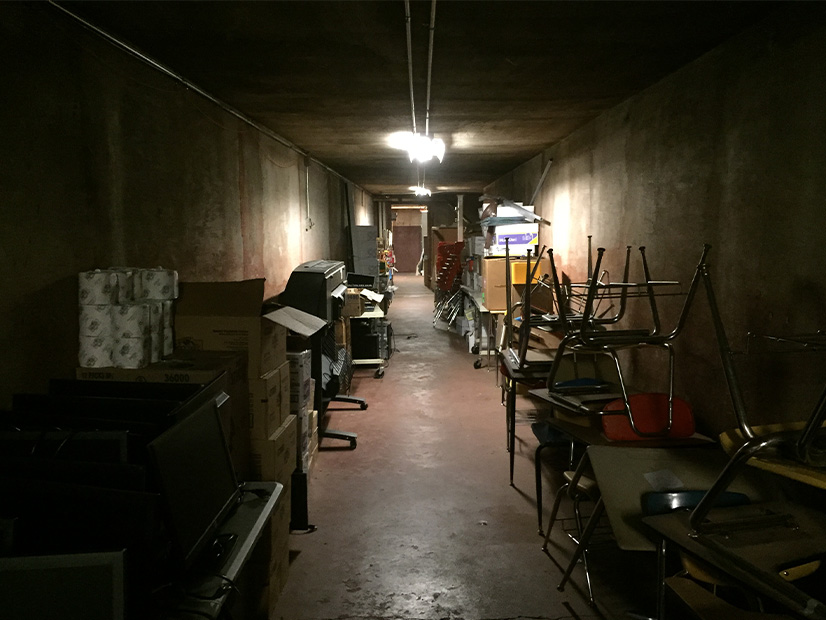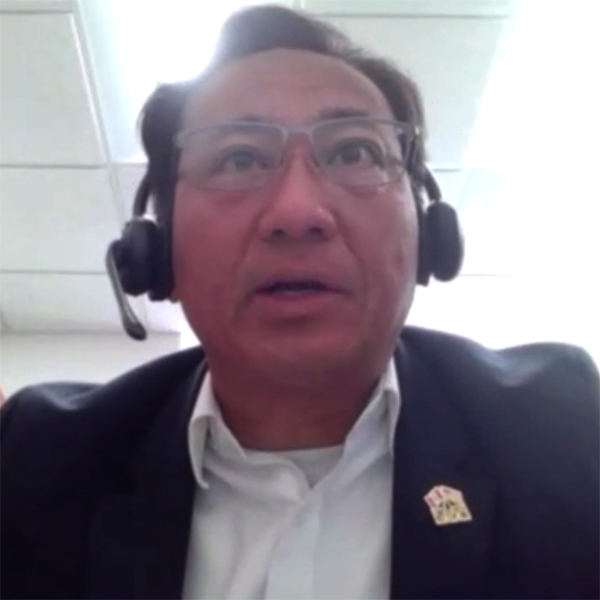Researchers at Michigan Technological University have wrapped a yearslong study that concludes many of the nation’s abandoned and flooded mines could become underground, long-term, pumped-storage facilities.
Studying a nearby closed mine shaft in Michigan’s Upper Peninsula, professors and graduate students determined that nearly 1,000 mines in the country could be repurposed into closed-loop hydroelectric storage facilities.
“We really can create a closed loop pumped hydro storage facility in an abandoned mine that is essentially invisible at the surface,” Michigan Tech associate professor of archaeology and anthropology Timothy Scarlett told RTO Insider in an interview. “We don’t really have to invent anything. It’s all of matter of using what has already been designed.”
Michigan Tech researchers concentrated on Mather B, a long-decommissioned iron-ore mine in Negaunee, Michigan, and extrapolated results to consider the applicability of such facilities on a national scale. They concluded proven and conventional pumped hydro equipment could be fitted into mineshafts. (See Mich. Energy Storage Idea Poses New Life for Old Mines.)
“What surprised me in the finding is how flexible this service can be in supplying grid services … We’ve concluded that this could do pretty much anything that MISO could ask it to do,” said Roman Sidortsov, associate professor of energy policy.
Research IDs 968 Mines as Storage Sites
Using data from the United States Geological Survey’s Mineral Resource Database System, the researchers identified 968 other abandoned mines across 15 states that could potentially host hydroelectric storage facilities.
Michigan Tech undergraduates worked with the university’s Alternative Energy Enterprise Team building a database of the country’s abandoned underground and combined underground and surface mines. They eliminated incompatible mines like open pits, mountaintop-removals and sites with weak structures.
“For example, we excluded coal mines because they’re usually more geologically unstable,” Scarlett said.
The team concluded that suitable mines could host up to 285 GW of daily power capabilities for partially underground storage facilities and 137 GW for fully underground facilities. The study pointed out that those values exceed the National Renewable Energy Laboratory’s (NREL) projections of storage needs to support an 80% renewable energy mix.
NREL’s recent Storage Futures Study projects from 100 to 650 GW of new storage capacity by 2050, all of which could support at least 80% of renewable generation penetration. The U.S. had about 23 GW worth of installed energy storage capacity in 2020.
Michigan Tech Researchers said a pumped hydro mine storage could become a seasonal asset, with four pumping and discharge cycles per year and a maximum cumulative power of 8.7 GW, or 8,010 GWh per season.
Mather B’s mine tunnels are now used as storage for nearby Negaunee High School | Mining History Association
The team analyzed Mather B’s dimensions, structural integrity, soil and water contamination, and property rights to come up with five pumped-storage designs that range from fully to partially subterranean and are capable of pumping different volumes of water. The designs use combinations of the shaft and surface pond, with equipment reaching to the mine’s mid- or deep levels.
“I joke with people that because there are so many ways to design this, it’s really a choose your own adventure book,” Scarlett said. “It is a question of what’s the most appropriate design, what are people most excited about? It doesn’t have to have a large visual footprint on the landscape.”
The team found the mine could support maximum power and energy capacities of 1,666 MWh under a daily energy storage model and 52,188 MWh for the seasonal energy storage model.
Scarlett said developers must refit a mine’s existing infrastructure with modern hydropower technology. But he said the turbine sizes and floodgates’ diameter are up to developers. He said designers could also use vertical boring mechanisms to add new shafts that take advantage of existing underground caverns.
“Nothing is prohibitively expensive; they’re all established mining practices,” Scarlett said, noting that developers can update old mine powerhouse and transmission systems for two-way power flows.
“Because these mines were big consumers of power in their operational lives, they either have already-active electricity hookups or legacy hookups,” he said.
Optimism for Concept
“I think we’ve made a really good case about why these facilities should be built,” Sidortsov said. “Based on the strides that companies in Europe are making, I think it will take off.”
Finland’s Pyhäsalmi Mine is set to host pumped-hydroelectric energy storage. Sweden boasts grid-scale energy storage company Mine Storage that develops and operates underground storage projects.
U.S.-based Rye Development has also filed an application with FERC for a 50-year permit to operate a 200-MW pumped-storage project in a former coal strip mine in Kentucky. Rye plans to complete the project by 2030.
Sidortsov predicted that underground pumped storage will be built on a “shift in the way we approach technology” that consists of “an alignment of not just the engineering bits, but the alignment of conviction of more people to engineer the facilities.” He said getting storage built in mineshafts requires “thoughtful government support” that holistically values resilience and takes a long view on energy assets.
Scarlett said an underground pumped-hydro storage facility could function like Michigan’s Ludington Pumped Storage Plant that’s been operating for 50 years.
“It’s been a profitable endeavor, not in a renewables environment, but in a coal- and nuclear-generation environment,” he said of the plant’s life span. “Once one of these is up and operating, there’s no reason to think that it couldn’t operate on a half to full-century timeframe.”
Scarlett said utilities “desperately” need to solve the problem of storing renewable output, calling it the “elephant in the room.” He said an array of storage options will be necessary and a mine storage operation can fill a need for otherwise limited grid-scale storage options. “I think people are going to be looking at this very, very seriously. It’s complicated and planning heavy, but it solves so many problems.”
A municipality could bank cheaper power at night, then sell it back to its own residents in a kind of “arbitrage driven by the community,” he said. Wholesale markets could also benefit from the facility’s ability to regulate load, shave peak and provide ancillary services and black start capability.
“It’s like a hydropower plant, where you can start it up quickly,” Scarlett said.
Michigan Tech researchers estimated the capital cost of draining the Mather B mine and installing a pumped storage facility at about $1.34 million/MW. Scarlett said Michigan Tech used “very cautious and reasonable” cost estimates.
“Mining companies dewater mines all the time and assess the mine integrity,” he said. “If one were really designing [pumped underground storage hydropower] in a mine, this would be a critical part of the work.”
Public-Private Partnerships
Scarlett said he envisions public-private partnerships producing the first mine storage facilities. He said states could invest in or provide subsidies for retrofitting.
“If you’re going to do it at scale and quickly, it’s going to be a big endeavor,” he said. “Convincing investors to do this is the risky part.”
The underground storage facilities would have variable profits depending on a multitude of factors, including design choices, but they “could be made to be profitable rather quickly,” Scarlett said.
“It will likely be expensive to build these facilities at first … but the advantages of building a large-scale pumped hydro facility underground and doing so quickly are tremendous. It makes it a very compelling case from a social perspective,” he said.
“Deployment of these facilities can be streamlined though public-private partnerships because many potential sites are located on public lands and can provide a wide range of benefits to the surrounding communities,” Sidortsov said. “What I’m not very optimistic about is the ability of our industry and governments to forge this kind of public-private partnerships. It doesn’t mean that the idea is doomed. It needs a positive and sustained momentum … If those things emerge, then we might be talking about kind of a revolution.”
He said a mine’s pumped storage facility will likely be on par financially with conventional pumped storage.
“So, we’re already at least in the vicinity, in the ballpark,” Sidortsov said. He said that though “virtually any energy technology has higher costs before it is deployed at scale, underground pumped storage can be an exception to this rule because of the reuse of the existing infrastructure, subterranean spaces and surface mine sites.”
“In the last three decades or so, the conventional wisdom about pumped storage hydro development has been that it was no longer feasible at scale in the U.S. because of the site availability,” he said. “Well, now we have at least 962 potential sites that pose lower environmental and community acceptance barriers. It would be a shame to not take advantage of them.”
Sidortsov added that the facility could create economic development “in areas that are really hard to develop economically.” He said pumped storage in mines could become firm, hybrid resources for rural areas where electricity rates tend to run high.
“If you do that, there’s an incidental benefit for other things, maintenance jobs, construction jobs [and] lower electricity rates,” he said. He said some of the ideal mine sites identified by Michigan Tech are in California, “where there’s a dire need for storage.”
A Hedge Against Severe Weather
A mine’s environment can provide a buffer against increasingly extreme weather and most natural disasters, Scarlett said.
“Of all those surface issues — save for earthquakes — the mine is the ideal storage facility,” he said. “You can’t drive a truck bomb into it, right? It’s underground. There are several non-monetized benefits to this.”
Sidortsov agreed that an underground pumped storage facility will be less vulnerable to floods and droughts.
“You would be fairly certain about what the total capacity would be. In the mine, there’s no evaporation. It’s only in-flow,” he explained.
If built at maximum capacity, a storage facility in the Mather B mine could furnish three-and-and-a-half months of uninterrupted power to its surrounding communities should they be islanded from the larger grid, Scarlett said.
He said the hydropower storage operations could tackle environmental improvements and pumping could be paired with a water-remediation system.
“Generally, whenever you talk about a mine, there are concerns about water quality,” Scarlett said. “You could attach water treatment to the facility, where the water gets treated during operations, and so the facility could actually improve the local ecosystem rather than continuing existing polluted discharges.”
He said some developers might be able to take advantage of water-remediation tax incentives. Older mines continue to leak contaminated water into communities “because no one is financially responsible” for them, Scarlett said.
An energy storage facility that also can mitigate environmental damage could be an “ideal solution” for communities experiencing cultural depression and economic contraction after mine closures, Scarlett said. The team’s next steps are to help those communities assemble their own analyses patterned on the Michigan Tech study.
“It’s what drives me in this work,” Scarlett said. “Communities can be involved in steering the direction of development.”
The research leads also said the team will examine pairing mine storage facilities with other energy operations, such as solar and wind generation or geothermal energy, that use the warm water already pumped up. Scarlett said new analyses may lead to developers selling minerals reclaimed from the filtering process.
“We’re at a point where we can think about combined systems and nesting them in different ways,” Scarlett said. “We wanted our … first study to show just how a facility would work on its own. Now, we want to show it in partnership with other uses.”
He said he’d like his team’s study to lead to more modeling in the U.S. on “how infrastructure can be reimagined to be multipurpose.” He said energy storage in abandoned mines can become a “sustainable economic engine … especially once industrial wealth commercialization leaves, and often leaves these communities hurting.”
Sidortsov said he foresees the Mather B mine becoming a good site for further studies or a pilot project.
“Frankly, there still has to be a lot of studying done before we can proclaim it as a commercially scalable technology,” he said.
Sidortsov said he views the concept as a “regulatory, economic, engineering and cultural Lego game” more than the creation of a new technology. “You’re not inventing anything new. You’re inventing a new way for those components to fit together, and the Lego figure that emerges at the end can be of a truly transformative kind.”



